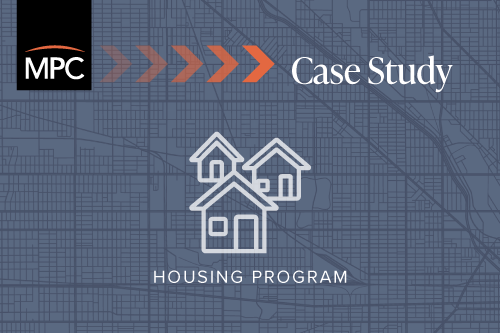Micro Market Recovery Program
Chicago, Cook County
Housing Program

Program background
The Micro Market Recovery Program (MMRP) started in 2011 as a response to the foreclosure and vacancy challenges Chicago faced in the wake of the foreclosure crisis. Surveying conditions throughout Chicago revealed stark discrepancies in housing distress from neighborhood to neighborhood; some communities were scarcely affected by foreclosures and vacancy, while others required significant intervention in order to stabilize the local housing market. To address those neighborhoods that were hardest hit, the City developed the MMRP, which concentrated resources to fight foreclosure and improve housing conditions in 13 different target areas.
How it works
Once the program concept was developed, the City prioritized the creation of geographic boundaries for each of the 13 target areas. MMRP partners were designated for each target area and worked with a central coordinator at LISC to inventory vacant and foreclosed properties in target areas, identify owners of troubled properties and present recommendations to City officials and technical assistance providers. Chicago’s Planning, Building and Law Departments met together regularly to prioritize and track progress on interventions. Meanwhile, the technical assistance providers from Neighborhood Housing Services, the Community Investment Corporation and, later, Elevate Energy would work with existing homeowners the community partners identified to deploy financing and rehab tools that could keep these owners in their homes and improve affordability.
The success of MMRP largely relied on the organizing work of local partners. The geographic boundaries of each target area were intentionally limited to allow community partners to blanket an area. Organizations that were focused on building relationships with homeowners helped to establish credibility and trust and supplemented existing data with on-the-ground knowledge of neighborhood conditions, both of which were critical to settling on appropriate and effective interventions.
The second round of MMRP will implement lessons learned over the past 6 years. MMRP is intentional about bringing partners from across all of the target areas together to discuss their most pressing housing challenges and identify issues that may require stronger action from the City. The City and its partners are seeking to move beyond the first round’s emphases on foreclosure and vacancy to more holistically target housing distress. That’s why LISC is now working with each community partner to create a simple strategy to connect housing issues with other area activities such as commercial revitalization and transportation enhancements. Making these connections will allow MMRP to leverage investments made in housing improvements and attract new homeowners and investment into target areas.
-
Goal
Stabilize local property values, by reducing the cost of home ownership, creating communities of choice, and attracting new owners to vacant buildings.
-
Target
The first round of the program included 13 low- to moderate income target areas throughout the City. The second round will include 9 target areas.
-
Financing
City of Chicago, Illinois Attorney General foreclosure settlement funds, LISC line of credit
-
Successes
- Reduced vacant properties, putting 756 building back in use and 2,081 units of housing
- 74 families saved from foreclosure
- 282 families used financing and rehabilitation resources to make housing costs more affordable
- Stabilized neighborhoods resulting in reduced crime, improved schools and increased community involvement.
-
>Lessons learned
- Geographically targeted work in small areas allows stabilization that is visible and can then be expanded to surrounding areas.
- Working with local partners that have on-the-ground credibility and trust is critical. Local partners can be different types of institutions, but must have existing neighborhood relationships and knowledge and ability to proactively engage directly with residents and homeowners.
- Successful housing strategies leveraged other local activity in schools, commercial corridors and other local institutions to cross-market the multiple assets of the community.
- Municipalities should establish a coordinated system of communication when multiple departments are considered stakeholders in a project. Operating in isolation is more resource-intensive and less effective.